Pilot Briefing: One fast cat
Rocket’s latest project is the Cougar Baron
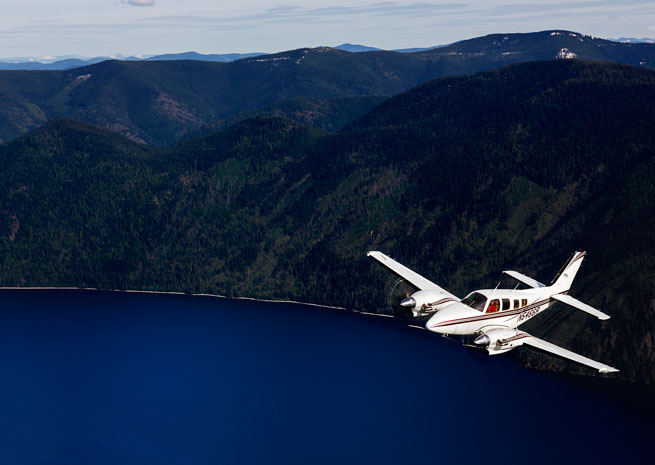
On a recent visit to Spokane, Washington’s Felts Field, AOPA Pilot got a first look at Northwest Turbine’s latest conversion undergoing certification. The Cougar Baron is a Beechcraft 58P outfitted with a pair of 500-shaft-horsepower Pratt & Whitney PT6A-21 turboprops. Rocket Engineering is doing the certification legwork for partner company Northwest Turbine LLC, which also markets the Royal Turbine conversion of the Beechcraft Duke.
As one may expect, hanging 1,000 horsepower on a maximum 6,200-pound airframe makes a serious performer. Company founder Darwin Conrad let us unleash the Cougar on a short test flight on a recent warm day. Takeoff performance can be described in two words: Hang on! Even at a 4,000-foot density altitude, the Cougar leapt off the runway in about 1,000 feet after a rolling takeoff. Climb rate is an exceptional 3,000 to 4,000 feet per minute. We passed 10,000 feet in 2.5 minutes and leveled at FL230 in nine minutes. Total burn from taxi out to FL230 was 18 gallons. Once level, the Cougar Baron accelerated to more than 290 KTAS while burning a total of 68 gph. At 250 KTAS, fuel flow drops to 50 gph. I wanted to see how much fuel the Cougar would use at the stock 58P’s typical 215 KTAS cruise speed, so Conrad simply shut one engine down—sure enough, 215 KTAS on 36 gph. For descent, simply pull the power back to idle and you can come down at 3,000 feet per minute. The Cougar needs only about 1,000 feet of pavement for landing.
Conrad estimates certification in about a year. Conversion cost is expected to be $850,000, not including a donor airframe.
On the web: www.cougarbaron.com
Pilotless aircraft tested on carriers
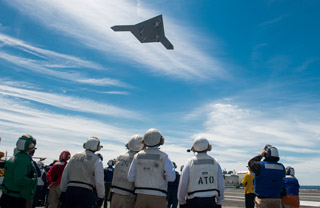 By the time you read this the first trap onboard a carrier of anunmanned aircraft will have been made. The remotely piloted X–47B was catapulted from the U.S.S. George H.W. Bush, made a couple of passes over the carrier, and then landed at Naval Air Station Patuxent River.
By the time you read this the first trap onboard a carrier of anunmanned aircraft will have been made. The remotely piloted X–47B was catapulted from the U.S.S. George H.W. Bush, made a couple of passes over the carrier, and then landed at Naval Air Station Patuxent River.
Within 72 hours it was back, doing touch and goes aboard the carrier but not stopping. Only a fullarrested landing remains to prove the concept.
Naval leaders said the tests demonstrate the future of the U.S. Navy. One day a captain will have a photo behind his desk of the landings that took place this spring, one officer observed. The aircraft aboard his ship will be mostly pilotless.
Getting the new look
New parts and new paint
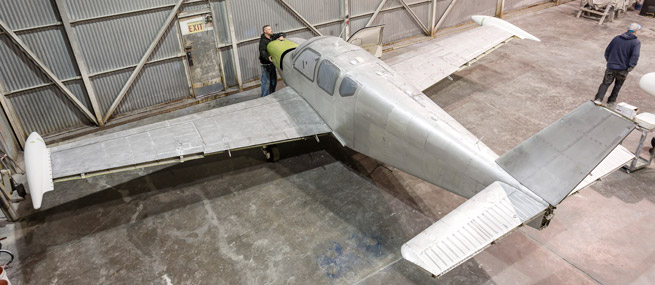
By Thomas A. Horne
By the time you read this, the AOPA Debonair Sweepstakes aircraft will have made yet another huge transformation—thanks to many generous contributors to the effort. When last we visited the Debonair in these pages, its new panel had been installed. And we even went on a flight, to KD Aviation at the Stewart International Airport in Newburgh, New York. KD is the Debonair’s paint shop, and, brother, this stop couldn’t come soon enough. That old—50 years old, to be precise—paint job needs to go!
I’ve been covering the process in my “Sweepstakes Logbook” blog, so for the latest news and photos check AOPA’s website. Which brings up another point: our website has been redesigned, if you hadn’t noticed. To find the Sweepstakes Logbook, go to the Membership tab on the homepage, then to the Sweepstakes link. Or direct access (www.aopa.org/membership/sweeps).
But back to paint. In prepping for the paint phase, KD’s Don Reese removed all the control surfaces, and found a cracked flap leading edge where the actuator rod is attached. Not a problem, however. Trusty Roy Williams of Airframe Components by Williams in Kendallville, Indiana, came through—again. Williams reskinned both flaps, fixing the bad actuator attach point in the process. He also signed off on a rudder airworthiness directive. Williams has helped us in the past, by providing a reconditioned stabilator for 2004’s “Win-A-Twin” sweepstakes Twin Comanche. Need control surface repairs? Call Roy.
Beechcraft provided a rare, critical component—a new cowling access door. The original door’s leading edge was all chewed up from 50 years’ worth of friction, and so the new door was a stroke of luck—and a very encouraging sign that, yes, the newly reconstituted Beechcraft really is committed to supporting its piston line. Even 50-year-old airplanes.
Select Airparts also stepped up to the plate. Select’s Michelle Souder checked out the Debonair in person at the Sun ’n Fun fly-in and pointed out that the left nosewheel door had a rather large notch, probably created by impact with a stone on some antediluvian takeoff. Well, Select sent the paint shop a replacement door from its stock of Beechcraft parts. Problem solved! Who says you can’t find parts fora 50-year-old airplane?
Knots2U—another long-time contributor to AOPA’s sweepstakes and restoration project airplanes—provided a new dorsal fairing, as well as a vertical stabilizertip fairing.
After stripping off the old paint and applying the airframe fixes, KD applied a base coat of Matterhorn white. That’s right, a solid white paint job will be the rule for the next few months. The stripes will come later. In the meantime, for your reading pleasure, we’ve applied decals explaining features of the airplane—and historical facts relating to the year of this Debonair’s birth. So if you’re going to be at EAA AirVenture this year, stop by AOPA’s big white tent and have a look at all the progress we’ve made. The new propeller will be worth a gander, as well.
Email [email protected]
Test pilot
1. What was the first American aircraft manufacturer to commercially produce airplanes?
2. A pilot lands during poor visibility on a runway with white centerline lighting. During the landing rollout and when the white lights begin to alternate with red lights, he knows that there are _______ feet of runway remaining. When the alternating red and white lights become red only, there are _______ feet of runway remaining.
a. 3,000; 1,500
b. 3,000; 1,000
c. 2,500; 1,500
d. 2,000; 1,000
3. What World War II combat aircraft had the shortest missions?
4. True or False? An old saw cautions not to eat yellow snow, but blankets of yellow snow really do occur in nature.
6. Many unimproved airports have a “runway halfway” sign to indicate the midpoint of a runway. According to the Aeronautical Information Manual, what rule of thumb can a departing pilot use to enhance safety when departing from such a runway?
7. From reader John Schmidt: Why was Veronica Lake, bombshell star of the 1941 film, I Wanted Wings (and many others), asked to trim her famously long, flowing blonde hair?
8. A pilot shuts down an engine, but it continues to run in an irregular manner for some time after the ignition is turned off. In an automobile, this is called dieseling. When occurring in an airplane, it is called _______ and caused by _______.
Pilot products
In-ear headsets
By Ian J. Twombly
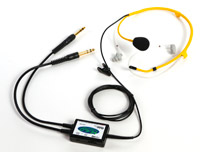 In the race to offer the “best” and most expensive headset, we hear names such as Bose, Lightspeed, Sennheiser, and others. Those companies all make great products, but they often ignore a category worthy of consideration—in-ear headsets.
In the race to offer the “best” and most expensive headset, we hear names such as Bose, Lightspeed, Sennheiser, and others. Those companies all make great products, but they often ignore a category worthy of consideration—in-ear headsets.
Made of simple and lightweight components, in-ear headsets traditionally are seen on corporate and airline flight decks. Two companies—Quiet Technologies and Clarity Aloft—currently are producing headsets for the general aviation market, and both should be contenders in your next headset search. Both headsets are constructed the same way. A metal band goes around the back of the head and over the tops of the ears. From that, tubing comes down and attaches to soft foam earplugs that can be swapped for size and comfort. The supplied earplugs are hollow, which allows radio communications to come through, but not aircraft noise. An adjustable boom microphone also is mounted on the band.
There’s actually little difference between the two models, except that perhaps Clarity Aloft uses slightly better components and comes with a nicer case. Then again, it costs more. Any difference in sound quality was imperceptible.
If you need Bluetooth for music or to pair a cell phone for clearances, Clarity Aloft is your only option—for a premium, of course.
If you’re accustomed to a standard over-the-ear headset, these in-ear models take a bit of getting used to. Get over the learning hump, however, and they are a joy to use. They are extremely light and comfortable, do a commendable job of noise reduction, both have nice audio quality, and they are significantly less expensive than a top-end traditional headset. As a bonus, if you are concerned about your hair (and really, what pilot isn’t?), they leave it fresh and undisturbed.
Email [email protected]
Wing walker, pilot killed during airshow performance in Ohio
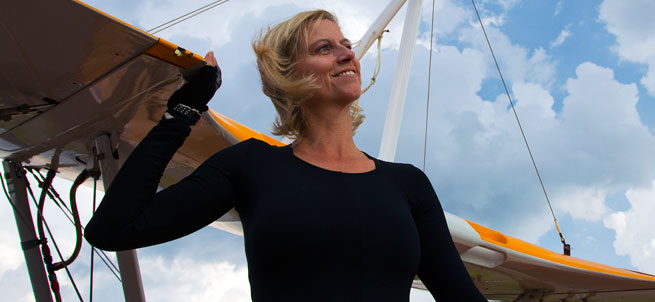
Wing walker Jane Wicker and pilot Charlie Schwenker were killed June 22 while performing at the Vectron Dayton Airshow near Dayton, Ohio.
Wicker’s 450-horsepower Stearman biplane crashed and burned during a low-altitude inverted pass. The FAA and NTSB are investigating the cause.
Wicker, 44, had been a budget analyst at the FAA. She began wing walking in 1990 for the Flying Circus in Bealeton, Virginia, after answering an advertisement in The Washington Post. She developed a unique routine with her then-husband, Kirk Wicker, in which she would hang upside down from the N-strut of a Stearman. After Kirk rolled the airplane inverted, Jane would be sitting upright on the underside of the lower wing. “It’s kind of a showstopper,” she told AOPA Pilot in the November 2011 feature story, “Walking Back On.”
Wicker left the airshow circuit after 2002 but returned in 2010 after purchasing and restoring her Stearman, which she called Aurora.
Schwenker, 64, was a longtime friend of Wicker’s and also performed for The Flying Circus in a Pitts S–1T and an Extra 300. He had participated in national aerobatic championships since 1990.
—Jill W. Tallman
Mojave mystique
Go ahead, take a risk
By Geri Silveira
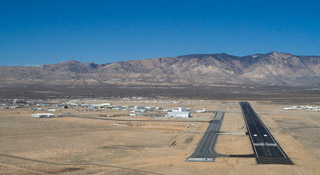 What’s so remarkable about Mojave Air and Space Port? Just about everything. Eighty miles north of Los Angeles, this desert airport may be in the middle of nowhere, but it’s also the center of the world’s most imaginative thinking in aviation and space.
What’s so remarkable about Mojave Air and Space Port? Just about everything. Eighty miles north of Los Angeles, this desert airport may be in the middle of nowhere, but it’s also the center of the world’s most imaginative thinking in aviation and space.
“You can feel the crackle of excitement here,” says Stuart O. Witt, CEO and general manager of the spaceport. “People want to come here. It’s the Mojave mystique. It doesn’t exist anywhere else in the world.”
A Marine Corps auxiliary air station until 1961, the facility is now home to an A-list of aviation tenants. Scaled Composites, famous for its nonstop, around-the-world Voyager flight in 1986, is the centerpiece of Mojave imagineers. Its rich history of innovation continues with prototypes such as WhiteKnightTwo, the high-altitude launch platform for SpaceShipTwo, the prototype for the world’s first commercial manned spaceship. Richard Branson’s Virgin Galactic is producing these vehicles for commercial space travel and has completed glide flights at the spaceport. Stratolaunch, the Paul G. Allen company, is producing the largest airplane ever built in a super-sized hangar here.
Rocket companies such as Masten Space Systems are literally having a blast at Mojave, with other companies coming from around the country to develop, build, and test their ideas. “We have numerous rocket tests every day,” said Witt. “In fact, we’ve had as many as nine in one day.”
The National Test Pilot School, the nation’s only civilian test pilot school, is based here, and so are numerous general aviation pilots—including two brothers who are building matching 70-percent-scale Grumman F8F Bearcats and a builder who’s developed an electric-powered Quickie.
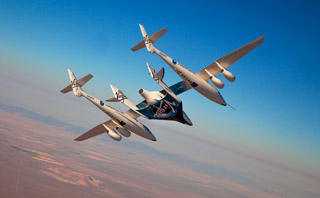 Unmanned air systems and optionally piloted aircraft have been testing their limits at Mojave for 60 years, and Incotec, a tenant for 20 years, recently produced its billionth aircraft fastener.
Unmanned air systems and optionally piloted aircraft have been testing their limits at Mojave for 60 years, and Incotec, a tenant for 20 years, recently produced its billionth aircraft fastener.
“We have at least one first flight a month here,” says Witt, a former Top Gun aviator and test pilot. “This week, a pilot who built a RV–7 made her first flight.”
And where else will you meet a student getting primary flight instruction from Dick Rutan? Karina Drees, director of marketing and business development, is doing just that.
The airport installed airport-wide fiber capability for state-of-the-art access to data. The airport also is rebuilding a crosswind runway, which will provide more utility for general aviation as well as a runway for potential returning space vehicles.
Passion for aviation is the source of the Mojave mystique. “We’re a collection of like-minded people competing for a common purpose,” says Witt. “At Mojave, we give people permission to take risks, to succeed and to fail.”
You don’t have to be a test pilot or a rocketeer to share the excitement. Fly into Mojave for the monthly Plane Crazy Saturday, an opportunity for vintage airplane owners to display their aircraft. Or, dine at the Voyager restaurant, where you can watch space-bound aircraft share the pattern with Cessna 150s.
S-LSA Light Sport aircraft flew an average of 80 hours per aircraft in 2010, but Experimental LSAs fly 35 hours and amateur-built aircraft flew 43 hours per year. E-LSAs make up about 80 percent of the LSA fleet.
Utah company offers $60,000 LSA
Approval expected this month
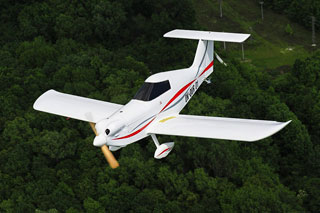 Many members have noted that there are few $60,000 LSA aircraft—the price originally forecast for the light sport aircraft segment announced a decade ago. Here comes one more to market. ASTM approval is expected in August for the single-seat, $54,850 Skycraft Airplanes SD–1 Minisport light sport aircraft. Orders will be taken at EAA AirVenture this summer. An official of the company said the Czech-designed aircraft flies much like a two-seat Van’s RV–6 aircraft. That aircraft is used by one company official as a trainer for the single-seat SD–1. It will be offered in both a tailwheel and nosewheel configuration.
Many members have noted that there are few $60,000 LSA aircraft—the price originally forecast for the light sport aircraft segment announced a decade ago. Here comes one more to market. ASTM approval is expected in August for the single-seat, $54,850 Skycraft Airplanes SD–1 Minisport light sport aircraft. Orders will be taken at EAA AirVenture this summer. An official of the company said the Czech-designed aircraft flies much like a two-seat Van’s RV–6 aircraft. That aircraft is used by one company official as a trainer for the single-seat SD–1. It will be offered in both a tailwheel and nosewheel configuration.
The company has offered the airplane as a kit for the past year. The price includes everything except a Mode S transponder and a ballistic parachute. The photo with this article is of an SD–1 aircraft flown in another country, since there are no photos as yet of the company’s test aircraft.
The F-23 Hirth two-cycle engine was designed from the start for aircraft use by Göbler-Hirthmotoren KG of Germany, and distributed in the United States by Recreational Power Engineering in Tiffin, Ohio. The air-cooled two-cylinder engine turns at 6,150 rpm to generate 50 horsepower. The company made large aircraft engines in the 1930s and 1940s, but had to stop making aircraft engines with Germany’s defeat in World War II. Up to 1974 the company made snowmobile engines. It revived its aircraft engine work with the growth of the ultralight industry in the 1980s.
The SD–1 is claimed to have a 118-mph cruise speed, a 1,400 fpm climb rate, a 39-mph stall speed, and five hours of endurance. Operational costs are claimed to be $12 an hour operational including fuel, oil, and engine overhaul. The engine has a 1,000-hour time between overhaul. The wings are removable.
The aircraft comes standard with a Dynon glass panel and radio, a digital instrument panel, fuel and power management systems, an emergency locator transmitter, and navigation and landing lights.
Email [email protected]
Phoenix chosen best LSA
The best commercial Light Sport aircraft at the 2013 Sun ’n Fun International Fly-In and Expo in Lakeland, Florida, was a Phoenix Motorglider. There are few production LSA gliders among the 131 models approved (seven of them no longer produced, leaving only 124 to choose from), and Phoenix Motorglider salesmen are proud. Phoenix Air’s U.S. distributor, Jim Lee, declared the award proof of the aircraft’s quality. “This award confirms what we have been saying for years—the fit, finish, and design of the dual-purpose Phoenix tops anything on the market.”
The Phoenix Motorglider had 10 registrations in 2012, putting it in a tie for sixth place among all S-LSA manufacturers. The leader in registrations was the Cessna Skycatcher with 94, followed by the CubCrafters Carbon Cub with 48 and the Aerotrek with 13. Flight Design has 14 percent of the market, the Skycatcher 11 percent, and the CubCrafters Carbon Cub 9.4 percent. Phoenix ranked twentieth with 0.5 percent of the market. The top 20 market leaders are ranked by bydanjohnson.com. —AKM
Dayton to build 250-foot Wright memorial
City wants its own icon
Dayton wants an icon for its city in the way St. Louis has its Gateway Arch. One is in the works and will firmly establish the town as the birthplace of aviation. Within three years a group in Dayton, Ohio, could start work on a 25-story monument at the north end of Dayton with a replica of a 1905 Wright Flyer atop it.
The Wright Image Group needs to raise $12 million for the project. Walter Ohlman, president of the group, said it now has $1 million plus the land for the memorial. Since it is near the airport, the group also has permission of the FAA and the airport, and since it is near two busy interstate highways, it has the approval of the Ohio State Patrol.
Engineering students at Ohio State University have completed analysis of aerodynamic forces that could exert tons of force on the wings of the Wright Flyer. The students built on earlier work done by the University of Dayton and used computer models and the OSU 3x5 foot wind tunnel to estimate the forces generated by wind velocities up to 220 mph. A final number for the amount of force on the model has not been calculated. The wingspan is 120 feet, the exact distance of the Wright’s first flight. The original restored 1905 Flyer is on display at Carillon Historical Park in Dayton. —AKM
AOPA wants answers on aircraft searches
After a growing number of reports from pilots being stopped by armed federal agents on the ramp, their aircraft searched by federal agents, AOPA is questioning the U.S. Department of Homeland Security Customs and Border Protection’s authority to conduct the searches.
Nearly a dozen pilots have reported encounters similar to New York pilot Gabriel Silverstein, who was detained and searched in May. Other pilots have been stopped and detained more than once by CBP agents operating well inland of borders. “We don’t know why they are being stopped,” said AOPA General Counsel Ken Mead, saying that the association will press the issue until satisfactory answers—or a change in policy—are forthcoming.
As the association works to gain a fuller understanding, AOPA has prepared the best advice possible, under the circumstances, for what to do if a search happens to you. A convenient kneeboard reference card has been created (www.aopa.org/advocacy). This step-by-step guide includes general procedures to follow when subjected to detention and search. Be courteous and respectful, and remain calm. Answer questions truthfully but succinctly: Do not volunteer information.
'Fifi' among superstars at Summit
Eye candy at Airportfest
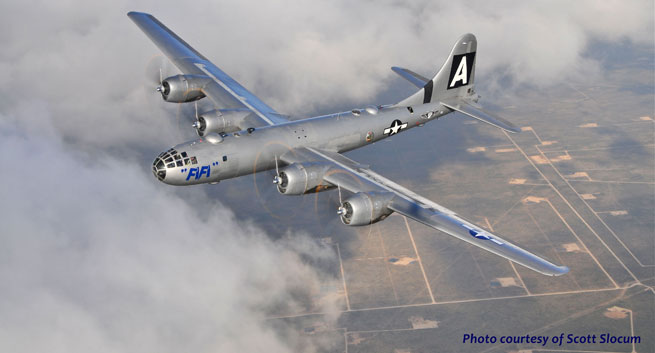
By Julie Summers Walker
The Commemorative air Force AirPower History Tour is scheduled to appear at AOPA Aviation Summit, to be held this year in Fort Worth, Texas, October 10 through 12. This will be the first time Summit is planned for the center of the country. Fifi, the B–29 Superfortress, is the headliner for the AirPower tour, which also includes Diamond Lil, a B–24 Liberator; Bucket of Bolts, a C–45 Expeditor; The Brat III, P–51 Mustang; and a T–6 Texan.
Also scheduled to appear on display is the Pacific Prowler B–25 and Southern Cross C–47 from the Greatest Generation Aircraft organization. A hot air balloon will also appear and details on having “Dusty,” the crop duster from Disney’s Planes movie (see “Truth in Animation,” page 68), were still being worked on at press time.
Airportfest will be held at Fort Worth Meacham International Airport. Featuring nearly 100 aircraft on display—from the warbirds to vintage aircraft, Light Sport to new jet designs—Airportfest offers the opportunity for attendees to experience general aviation up close and personal. Airportfest also features live music, food concessions, aircraft demonstration flights, aerial helicopter tours, special guest speakers, and aviation activities for adults and children alike. AOPA’s Learn to Fly Center is also located at Airportfest.
On Saturday, October 12, AOPA will host “Pilots, Planes, and Pancakes,” a pancake breakfast featuring a keynote speaker. Hear updates on the latest in general aviation news and mingle with fellow pilots, while enjoying an old-fashioned pancake breakfast.
Other events scheduled for Summit 2013 include “Chow Down in Cowtown,” a Friday evening event at Fort Worth’s historic Stockyards. Famous Riscky’s barbeque, a local favorite since 1927, will be served. Live country music and a comedy gunfight are just part of the planned entertainment. Guests will also view the best in rodeo and Western action at the Cowtown Coliseum.
On Saturday evening, guests will step back in time at Fort Worth’s Vintage Flying Museum for a 1940s-style hangar dance. Dinner and dancing to the sounds of Glenn Miller, Harry James, and other great musicians from the era—as well as live swing dance performances—will highlight the evening. Aircraft on display in the museum include an A–26, B–25, and T–33.
Email [email protected]
Test Pilot answers
1. In May 1908, the Glenn H. Curtiss Company of Hammondsport, New York, offered airplanes for $5,000 each and said that orders would be filled in 60 days.
2. (b) Such a centerline lighting system normally is associated with runways served by an instrument landing system (ILS).
3. Germany’s Messerschmitt Me–163, the world’s only rocket-powered fighter, could carry enough fuel for only about 7 minutes of flight.
4. True. Yellow snow can occur when substantial quantities of pollen are blown into the atmosphere and serve as hygroscopic nuclei about which snowflakes can form.
5. The Martin AM–1 Mauler was a carrier-based attack aircraft in the U.S. Navy that had a maximum takeoff weight of 26,000 pounds. The Grumman AF–2 Guardian tipped the scales at 25,500 pounds, and the most successful of the three heaviest singles, the Douglas A–1 Skyraider, weighed 25,000 pounds.
6. The rule of thumb states that a pilot should abort the takeoff if 70 percent of the required liftoff speed is not achieved at the halfway point, because it might not be possible to lift off in the remaining distance. (Refer to AIM 7-5-7 for other considerations.)
7. Her hair style was widely emulated by many of her “Rosie the Riveter” fans. However, such long hair on aircraft factory workers endangered those working with lathes, drill presses, etc. Lake trimmed her iconic peek-a-boo hairstyle to encourage women workers to adopt more practical, safer hairstyles. (Veronica Lake also was acertificated pilot.)
8. Preignition. It is caused by carbon deposits or other hot spots in one or more cylinders that ignite fuel in the combustion chamber(s) after the magnetos have been turned off.


